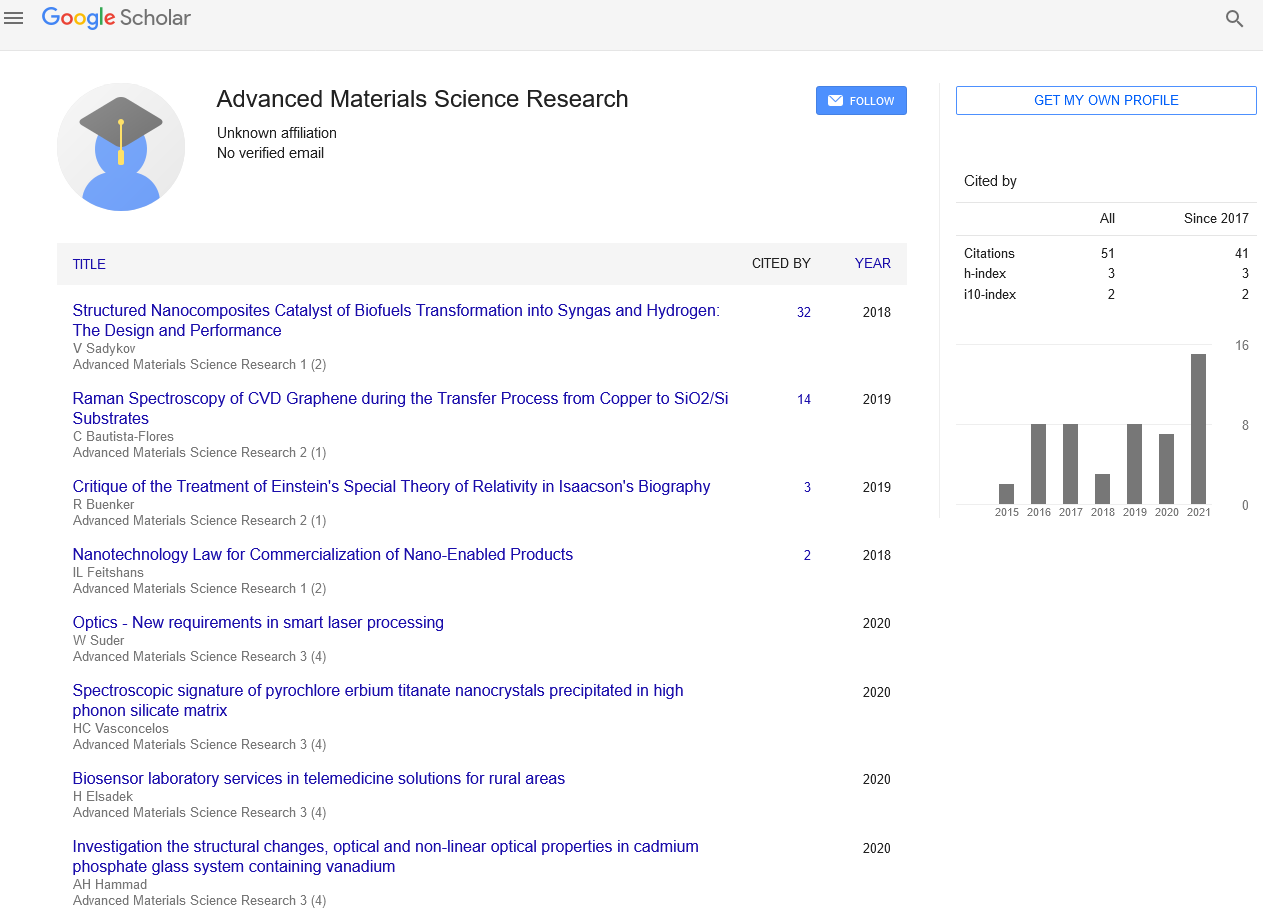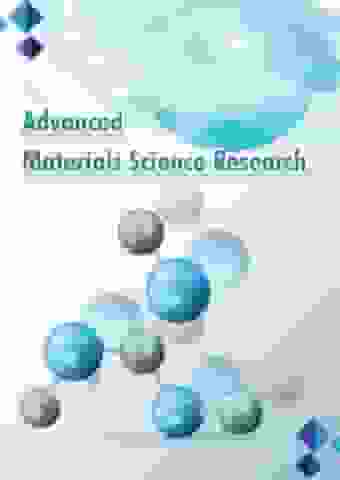Editorial - Advanced Materials Science Research (2023) Volume 6, Issue 4
Advancements in Superconducting Materials Paving the Way for a Revolutionary Future
Jiten Sign*
Department of Mechanical Engineering, Indian Institute of Technology Madras, India
Department of Mechanical Engineering, Indian Institute of Technology Madras, India
E-mail: Sjiten3@gmail.com
Received: 01-Aug-2023, Manuscript No. AAAMSR-23-108062; Editor assigned: 03-Aug-2023, Pre-QC No. AAAMSR-23-108062 (PQ); Reviewed: 17-Aug-2023, QC No. AAAMSR-23-108062; Revised: 22-Aug-2023, Manuscript No. AAAMSR-23-108062 (R); Published: 29-Aug-2023; DOI: 10.37532/ aaasmr.2023.6(4).70-72
Abstract
Superconducting materials have emerged as a groundbreaking class of materials with unique properties that revolutionize various fields of science and engineering. These materials exhibit zero electrical resistance when cooled below a critical temperature, enabling the transmission of electricity with unprecedented efficiency. This abstract delves into the remarkable properties, applications, and ongoing advancements in superconducting materials. This paper begins by elucidating the fundamental principles of superconductivity, describing the underlying mechanisms that lead to the lossless flow of electrons in superconductors. It explores the two main types of superconductors: Type I, which exhibit abrupt transitions to the superconducting state, and Type II, which demonstrate a more complex behavior with the existence of a mixed state. Subsequently, the abstract delves into the significant impact of superconducting materials in various domains. Superconducting magnets have been instrumental in medical imaging (MRI), particle accelerators, and magnetic levitation (maglev) trains, dramatically enhancing precision, resolution, and energy efficiency. Furthermore, superconducting power cables have emerged as a promising solution for minimizing energy losses during long-distance transmission, potentially revolutionizing power distribution networks. In recent years, extensive research efforts have been directed towards discovering novel superconducting materials, especially those that can operate at higher temperatures, closer to room temperature. The discovery of high-temperature superconductors, such as curates and iron-based compounds, has opened up new possibilities for practical applications and expedited the adoption of superconducting technologies in real-world scenarios. The challenges associated with implementing superconducting materials, such as the need for cryogenic cooling and material instability under high magnetic fields. Researchers are actively investigating various approaches to overcome these limitations, including advances in cryogenic engineering, the development of innovative fabrication techniques, and the exploration of exotic materials.
Keywords
Superconducting materials • Electrons • On-going • Transformative technological
Introduction
Superconducting materials have been captivating the scientific community for over a century, but recent advancements in their development and application have sparked a renewed interest in these enigmatic substances. Superconductors are materials that exhibit zero electrical resistance and expel magnetic fields when cooled below a critical temperature [1]. This unique property, known as superconductivity, enables the efficient flow of electric current without any energy loss. As researchers delve deeper into the potential applications of superconducting materials, they hold the promise of revolutionizing various industries, from energy transmission to transportation and beyond. Superconducting materials have demonstrated their immense potential in revolutionizing multiple industries through their unique ability to carry electric current without resistance. Ongoing research and development continue to expand the boundaries of superconductivity, paving the way for transformative technological advancements and a more sustainable future.
By harnessing the power of superconducting materials, humanity can unlock unparalleled efficiency, reduced energy consumption, and enhanced capabilities in a wide array of applications [2, 3].
Historical overview
The discovery of superconductivity dates back to 1911 when Dutch physicist Heike Kimberling Onnes observed the phenomenon in mercury cooled to extremely low temperatures. However, it wasn't until 1933 that the theoretical foundation of superconductivity was laid by Fritz and Heinz London. They proposed the existence of a "Cooper pair" – a phenomenon in which two electrons form a bound state due to lattice vibrations [4]. This interaction, known as the BCS theory (Bardeen, Cooper, and Schrieffer), revolutionized the understanding of superconductivity and earned John Bardeen, Leon Cooper, and John Schrieffer the Nobel Prize in Physics in 1972.
Type I and II superconductors
Superconducting materials can be categorized into two types: Type I and Type II superconductors. Type I superconductors expel all magnetic fields when they transition into the superconducting state and are primarily used for fundamental research purposes. In contrast, Type II superconductors permit the partial penetration of magnetic fields, enabling them to retain their superconducting properties in higher magnetic fields. This characteristic makes Type II superconductors more practical for various applications [5].
High-temperature superconductors (HTS)
In the 1980s, a major breakthrough occurred when researchers discovered a new class of superconducting materials that exhibited superconductivity at higher temperatures than previously known. These materials, known as high-temperature superconductors (HTS), captured significant attention due to their potential for practical applications [6]. The discovery of cuprate-perovskite materials, such as yttrium barium copper oxide (YBCO), which could superconduct at temperatures above the boiling point of liquid nitrogen (~77K or -196°C), was particularly groundbreaking. This advance opened up new possibilities for more accessible and cost-effective cooling methods, as liquid nitrogen is widely available and less expensive than traditional liquid helium cooling.
Applications of superconducting materials
Power transmission and storage:
Superconductors can significantly enhance the efficiency of power transmission and storage systems. With zero electrical resistance, these materials can carry electricity over long distances without substantial energy loss. This can lead to a more sustainable and efficient power grid [7].
Magnetic levitation: Superconductors exhibit perfect diamagnetism, causing them to repel magnetic fields. This property is harnessed in Maglev trains, where superconducting magnets enable frictionless and high-speed travel. Medical imaging: Superconducting magnets are crucial components in magnetic resonance imaging (MRI) machines, providing highresolution images for medical diagnosis and research [8].
Particle accelerators: Large particle accelerators, like the Large Hadron Collider (LHC), utilize superconducting materials to generate the intense magnetic fields needed to accelerate particles to near-light speeds.
Quantum computing: Superconducting qubits, used in superconducting quantum computers, hold promise for solving complex computational problems that are beyond the reach of classical computers.
Challenges and future outlook
Despite significant progress, several challenges remain in the field of superconducting materials. One of the main hurdles is achieving superconductivity at even higher temperatures, moving closer to room temperature. This would enable more practical applications and reduce cooling costs further.
Additionally, the cost of producing
superconducting materials, especially those using rare elements, needs to be addressed for widespread adoption in various industries [9, 10].
Conclusion
Superconducting materials have evolved from a scientific curiosity to a class of materials that promises revolutionary advancements across various fields. Their unique properties, coupled with ongoing research and development efforts, continue to unlock new possibilities for more efficient energy systems, advanced transportation, and groundbreaking technologies. As scientists delve deeper into the intricacies of these materials, it is only a matter of time before superconductors play a pivotal role in shaping the future of technology and innovation.
References
- Himanen L, Geurts A, Foster AS et al. Data‐driven materials science: status, challenges, and perspectives.AdvSci.7, 1900808(2019).
- Obidin N, Tasnim F, Dagdeviren C. The future of neuroimplantable devices: a materials science and regulatory perspective.Adv Mater.32, 1901482(2020).
- Berggren K, Likharev KK., Strukov DB et al. Roadmap on emerging hardware and technology for machine learning. Nat Nanotechnol.32, 012002(2020).
- Karniadakis GE, Kevrekidis IG, Yang L et al. Physics-informed machine learning.NatRevPhys. 3, 422-440(2021).
- Geoffrey AO, Kuperman A, Stein A. Advanced zeolite, materials science. AngewChem IntEdEngl. 28,359-376(1989).
- Louie SG, Chan YH, Jornada FH et al. Discovering and understanding materials through computation. Nat Mater. 20, 728-735(2021).
- Pablo D, Juan K. Advancing and Accelerating Materials Innovation: New Frontiers for the Materials Genome Initiative.41, (2019).
- Ahmadpoor D, Mohammad V, Benjamin F et al. The dual frontier: Patented inventions and prior scientific advance. Science.357,583-587(2017).
- Shipp SS, Gupta N, Scott JA et al. Advancing manufacturing to new frontiers: Increasing opportunities for society.7, 71-81(2012).
- Xie D, Li Z, Zhu H et al. Recent advances in wearable tactile sensors: Materials, sensing mechanisms, and device performance. MaterSciEng. 115, 1-37 (2017).
Indexed at, Google Scholar, Crossref
Indexed at, Google Scholar, Crossref
Indexed at, Google Scholar, Crossref
Indexed at, Google Scholar, Crossref
Indexed at, Google Scholar, Crossref
Indexed at, Google Scholar, Crossref
Indexed at, Google Scholar, Crossref

